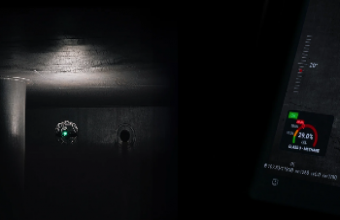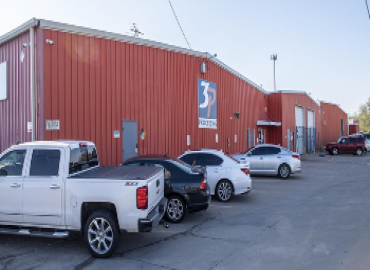The Swiss drone company Flyability announced the newest payload for their flagship Elios 3 drone on October 30t. The new payload is designed to give pilots peace of mind while flying in hazardous confined spaces: a flammable gas sensor.
The newest sensor is mounted onto the Elios 3, which is a non-destructive testing tool that operates in challenging confined spaces. Designed to be collision-tolerant, this drone is used to inspect assets that include ship ballast tanks, sewers, nuclear waste facilities, and more complex environments. The Elios 3 can carry various payloads according to the needs of an inspection flight, including a centimetre-accurate LiDAR scanner, an ultrasonic thickness probe, and a radiation detection dosimeter. The flammable gas sensor can be mounted at the same time as the other payloads and is designed to provide pilots with more information about their flight’s atmospheric conditions.
Flyability’s flammable gas sensor can detect over 14 different types of combustible gases, with comprehensive in-flight readings provided to the pilot of the Elios 3. The factory-calibrated payload is equipped with built-in self-testing, which means it requires no calibration when in the field. This is key for pilots as it ensures the sensor is an easy to use tool and does away with cumbersome set-up time.
The sensor is designed to be an extra safeguard for detecting flammable gases, complementing existing safety measures and protocols. The 14 gases it can detect are some of the most common combustible gases, including hydrogen, methane, and propylene. The drone’s sensor identifies these gases with a resolution of 0.1% Lower Explosive Limit (LEL), notifying the pilot of the gas type and concentration. Small changes in gas levels can be observed by the drone, which will provide the pilot with an early warning. The LEL threshold can also be adapted by the pilot before flight, so it can be customized according to the expected environment.
The flammable gas sensor for the Elios 3 was designed in partnership with gas sensor specialists NevadaNano. NevadaNano provides safety and climate solutions for many of the world’s largest corporations with multi-gas sensing products and continuous IoT monitoring systems. Once the sensor is mounted onto the drone, it can give accurate readings on various combustible gases in order to alert pilots about the atmospheric conditions around the drone.
The sensor relies on molecular property spectrometer (MPS) technology that was developed by NevadaNano. This technology is part of how the sensor has built-in self-test features and provides the most accurate readings on the market. This technology ensures reliable performance in the challenging environments Elios 3 drones are subjected to.
Flyability explains that pilots can see benefits in reaching higher safety standards, easing permit processes, and gaining greater peace of mind thanks to this technology. The reliable detection of flammable gases enhances the situational awareness of pilots so they can quickly adjust safety measures during drone operations. By using a drone that complements traditional handheld sensors, pilots can ensure continuous flammable gas monitoring which streamlines risk assessments and accelerates the process of getting permit approvals. Finally, pilots can rely on this additional data in high-risk areas to help them operate with the greatest possible confidence. The gas sensor adds an extra layer of safety and gives real-time awareness of potential hazards, so that pilots can be focused on the inspection at hand.
As part of the payload’s public launch, Flyability will host a webinar on November 12th with two members of their product team along with a webinar moderator. During the session, the Flyability team will present the payload and discuss the key features of the sensor. The initial presentation will cover the design of the payload and how it connects to the Elios 3, before moving on to explaining how it was tested and how the sensor works. The Flyability team will also discuss the expected applications of the drone with the payload, with a particular focus on the relevant industries of mining, oil and gas, and power generation amongst others. Finally, the webinar will conclude with a live Q&A for attendees to ask questions of the presenters. The entire session will be recorded and is available for registration via the Flyability website.
The flammable gas sensor marks the 4th payload for the Elios 3, and the second payload released in 2024. It is an exciting step forward for Flyability as they add yet another safety feature to their flagship drone and demonstrate the value of modularity in technology, which is a sustainable practice with increasing popularity. As non-destructive testing evolves, examples of multi-purpose inspection tools such as the Elios 3 demonstrate it is possible to remotely collect accurate data without compromising on the quality of results. This in turn empowers safer inspections across sectors and helps the non-destructive testing industry evolve as a whole.
Learn more about Flyability’s new flammable gas sensor along with the Elios 3 drone on their website. https://www.flyability.com/flammable-gas-sensor












